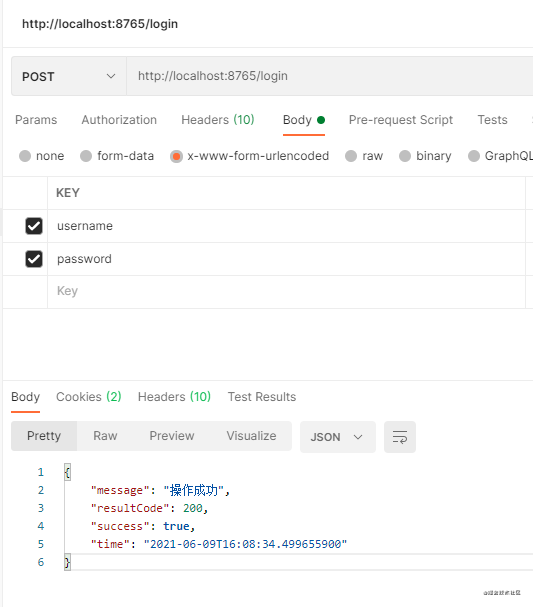Spring Security密码验证 Spring Security 密码验证动态加盐的验证处理方法
布吉_岛 人气:0本文个人博客地址:https://www.leafage.top/posts/detail/21697I2R
最近几天在改造项目,需要将gateway整合security在一起进行认证和鉴权,之前gateway和auth是两个服务,auth是shiro写的一个,一个filter和一个配置,内容很简单,生成token,验证token,没有其他的安全检查,然后让对项目进行重构。
先是要整合gateway和shiro,然而因为gateway是webflux,而shiro-spring是webmvc,所以没搞成功,如果有做过并成功的,请告诉我如何进行整合,非常感谢。
那整合security呢,因为spring cloud gateway基于webflux,所以网上很多教程是用不了的,webflux的配置会有一些变化,具体看如下代码示例:
import io.leafage.gateway.api.HypervisorApi;
import io.leafage.gateway.handler.ServerFailureHandler;
import io.leafage.gateway.handler.ServerSuccessHandler;
import io.leafage.gateway.service.JdbcReactiveUserDetailsService;
import org.springframework.context.annotation.Bean;
import org.springframework.http.HttpMethod;
import org.springframework.http.HttpStatus;
import org.springframework.security.config.annotation.web.reactive.EnableWebFluxSecurity;
import org.springframework.security.config.web.server.ServerHttpSecurity;
import org.springframework.security.core.userdetails.ReactiveUserDetailsService;
import org.springframework.security.crypto.bcrypt.BCryptPasswordEncoder;
import org.springframework.security.crypto.password.PasswordEncoder;
import org.springframework.security.web.server.SecurityWebFilterChain;
import org.springframework.security.web.server.authentication.HttpStatusServerEntryPoint;
import org.springframework.security.web.server.authentication.ServerAuthenticationFailureHandler;
import org.springframework.security.web.server.authentication.ServerAuthenticationSuccessHandler;
import org.springframework.security.web.server.authentication.logout.HttpStatusReturningServerLogoutSuccessHandler;
import org.springframework.security.web.server.csrf.CookieServerCsrfTokenRepository;
/**
* spring security config .
*
* @author liwenqiang 2019/7/12 17:51
*/
@EnableWebFluxSecurity
public class ServerSecurityConfiguration {
// 用于获取远程数据
private final HypervisorApi hypervisorApi;
public ServerSecurityConfiguration(HypervisorApi hypervisorApi) {
this.hypervisorApi = hypervisorApi;
}
/**
* 密码配置,使用BCryptPasswordEncoder
*
* @return BCryptPasswordEncoder 加密方式
*/
@Bean
protected PasswordEncoder passwordEncoder() {
return new BCryptPasswordEncoder();
}
/**
* 用户数据加载
*
* @return JdbcReactiveUserDetailsService 接口
*/
@Bean
public ReactiveUserDetailsService userDetailsService() {
// 自定义的ReactiveUserDetails 实现
return new JdbcReactiveUserDetailsService(hypervisorApi);
}
/**
* 安全配置
*/
@Bean
SecurityWebFilterChain springSecurityFilterChain(ServerHttpSecurity http) {
http.formLogin(f -> f.authenticationSuccessHandler(authenticationSuccessHandler())
.authenticationFailureHandler(authenticationFailureHandler()))
.logout(l -> l.logoutSuccessHandler(new HttpStatusReturningServerLogoutSuccessHandler()))
.csrf(c -> c.csrfTokenRepository(CookieServerCsrfTokenRepository.withHttpOnlyFalse()))
.authorizeExchange(a -> a.pathMatchers(HttpMethod.OPTIONS).permitAll()
.anyExchange().authenticated())
.exceptionHandling(e -> e.authenticationEntryPoint(new HttpStatusServerEntryPoint(HttpStatus.UNAUTHORIZED)));
return http.build();
}
/**
* 登陆成功后执行的处理器
*/
private ServerAuthenticationSuccessHandler authenticationSuccessHandler() {
return new ServerSuccessHandler();
}
/**
* 登陆失败后执行的处理器
*/
private ServerAuthenticationFailureHandler authenticationFailureHandler() {
return new ServerFailureHandler();
}
}
上面的示例代码,是我开源项目中的一段,一般的配置就如上面写的,就可以使用了,但是由于我们之前的项目中的是shiro,然后有一个自定义的加密解密的逻辑。
首先说明一下情况,之前那一套加密(前端MD5,不加盐,然后数据库存储的是加盐后的数据和对应的盐(每个账号一个),要登录比较之前对密码要获取动态的盐,然后加盐进行MD5,再进行对比,但是在配置的时候是没法获取某一用户的盐值)
所以上面的一版配置是没法通过验证的,必须在验证之前,给请求的密码混合该账号对应的盐进行二次加密后在对比,但是这里就有问题了:
- security 框架提供的几个加密\解密工具没有MD5的方式;
- security 配置加密\解密方式的时候,无法填入动态的账号的加密盐;
对于第一个问题还好处理,解决方式是:自定义加密\解密方式,然后注入到配置类中,示例如下:
import cn.hutool.crypto.SecureUtil;
import com.ichinae.imis.gateway.utils.SaltUtil;
import org.springframework.security.crypto.codec.Utf8;
import org.springframework.security.crypto.password.PasswordEncoder;
import java.security.MessageDigest;
/**
* 自定义加密解密
*/
public class MD5PasswordEncoder implements PasswordEncoder {
@Override
public String encode(CharSequence charSequence) {
String salt = SaltUtil.generateSalt();
return SecureUtil.md5(SecureUtil.md5(charSequence.toString()) + salt);
}
@Override
public boolean matches(CharSequence charSequence, String encodedPassword) {
byte[] expectedBytes = bytesUtf8(charSequence.toString());
byte[] actualBytes = bytesUtf8(charSequence.toString());
return MessageDigest.isEqual(expectedBytes, actualBytes);
}
private static byte[] bytesUtf8(String s) {
// need to check if Utf8.encode() runs in constant time (probably not).
// This may leak length of string.
return (s != null) ? Utf8.encode(s) : null;
}
}
第二个问题的解决办法,找了很多资料,也没有找到,后来查看security的源码发现,可以在UserDetailsService接口的findByUsername()方法中,在返回UserDetails实现的时候,使用默认实现User的UserBuilder内部类来解决这个问题,因为UserBuilder类中有一个属性,passwordEncoder属性,它是Fucntion<String, String>类型的,默认实现是 password -> password,即对密码不做任何处理,先看下它的源码:

再看下解决问题之前的findByUsername()方法:
@Service
public class UserDetailsServiceImpl implements ReactiveUserDetailsService {
@Resource
private RemoteService remoteService;
@Override
public Mono<UserDetails> findByUsername(String username) {
return remoteService.getUser(username).map(userBO -> User.builder()
.username(username)
.password(userBO.getPassword())
.authorities(grantedAuthorities(userBO.getAuthorities()))
.build());
}
private Set<GrantedAuthority> grantedAuthorities(Set<String> authorities) {
return authorities.stream().map(SimpleGrantedAuthority::new).collect(Collectors.toSet());
}
}
那找到了问题的解决方法,就来改代码了,如下所示:
新增一个代码处理方法
private Function<String, String> passwordEncoder(String salt) {
return rawPassword -> SecureUtil.md5(rawPassword + salt);
}
然后添加builder链
@Service
public class UserDetailsServiceImpl implements ReactiveUserDetailsService {
@Resource
private RemoteService remoteService;
@Override
public Mono<UserDetails> findByUsername(String username) {
return remoteService.getUser(username).map(userBO -> User.builder()
.passwordEncoder(passwordEncoder(userBO.getSalt())) //在这里设置动态的盐
.username(username)
.password(userBO.getPassword())
.authorities(grantedAuthorities(userBO.getAuthorities()))
.build());
}
private Set<GrantedAuthority> grantedAuthorities(Set<String> authorities) {
return authorities.stream().map(SimpleGrantedAuthority::new).collect(Collectors.toSet());
}
private Function<String, String> passwordEncoder(String salt) {
return rawPassword -> SecureUtil.md5(rawPassword + salt);
}
}
然后跑一下代码,请求登录接口,就登陆成功了。

加载全部内容